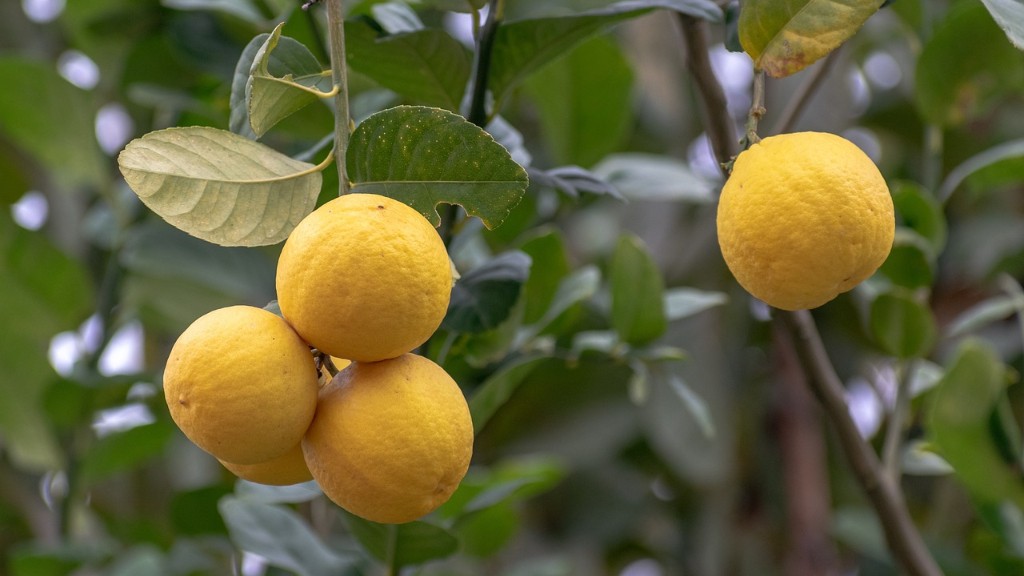Growing a lemon tree from seed requires patience and consistent effort. However, the results of a successful crop of lemons make all the effort worthwhile. To start the process, you’ll need to gather the materials, such as lemon seeds, potting soil, a pot and fertilizer. You’ll also need to prepare the lemon seed by soaking them in water overnight.
Next, plant the soaked seeds in a pot filled with potting soil. Prepare the soil by adding a few tablespoons of fertilizer. Make sure your seeds are planted ¼ inch below the soil’s surface otherwise they won’t germinate. Place the pot in an area that receives a significant amount of direct sunlight for at least 5 hours a day.
After planting the seeds, it’s important to keep the soil moist. Water the seeds twice a day but make sure you don’t drown the lemon tree by adding too much water. Use a spray bottle for more precision when watering. Place the pot on a shallow tray filled with water to keep the soil moist for a longer period of time.
You’ll notice the seeds will begin to germinate within several weeks. If cared for correctly, sprouts will appear. Make sure to move the pot to an area that receives more sunlight, since young lemon trees need more of it. Also, keep in mind to fertilize the lemon tree, using a small amount once a week.
Since lemon trees are prone to pests and disease, always be on the lookout. Pruning will help your lemon tree grow with a healthy branch structure. Removing excessively large, dead or broken branches will make sure the tree retains its shape. Prune the lemon branches so they can receive the correct amount of sunlight and air circulation.
Providing adequate air circulation and light is paramount to keep your lemon tree healthy and growing. Keep the lemon tree in an area with plenty of sunshine, no matter if it is indoors or outdoors. Pay close attention to the tree and adjust its location if you don’t see any visible growth.
Pruning Lemon Trees
Pruning is a critical part of growing a lemon tree from seed. Proper pruning requires removing any limbs that cross over other branches, as well as any dead, diseased or broken branches. In addition, any branches that are excessively growing in size or are blocking the lemon tree’s visibility need to be pruned as well. The faster and thicker growing branches should be pruned first, while the slower and thinner growing ones should be left be.
When pruning the lemon tree, be sure to make the cuts at the correct angle. This will prevent water and disease from entering the tree. Make sure to use sharp pruning scissors and cut above another branch or a node. Thinning out will help the lemon tree get enough light and warm the branches evenly.
It’s best to prune the lemon tree prior to its flowering stage, as it will encourage new growth quickly. It’s especially important for young lemon trees, as pruning will help create a strong branch structure and direct the tree’s growth in the right direction.
Pruning should be done twice a season, in late winter and late summer. Make sure to observe the lemon tree and its changes daily, in order to make sure the tree is not affected by any pests or illnesses. If some diseased limbs are noticed, it’s important to prune them as soon as possible.
Fertilizing Lemon Trees
Fertilizing lemon trees is another important step in successful lemon tree growing from seed. The key is to use the right kind of fertilizer. Use a slow-release fertilizer with nitrogen, potassium and phosphorus. These are all essential for maintaining healthy foliage and plentiful fruit growth.
It’s important to apply the fertilizer in the spring prior to the lemon tree’s blooming period as this will help keep the soil nourished. Choose a fertilizer that is specially formulated for citrus trees and not any other type of plants. Fertilizing can be done 2 or 3 times a year, depending on the size of the lemon tree.
Fertilizer should be applied at the base of your lemon tree and not directly on the leaves. Make sure to spread the fertilizer evenly underneath the tree’s foliage, but don’t be too heavy-handed as over-fertilizing can harm the lemon tree’s roots. Make sure to water the soil after applying the fertilizer.
It’s crucial to pay close attention to your lemon tree’s leaves. If they take on a yellowish hue, this might be an indication of over-fertilizing. Keep in mind that fertilizing can be accomplished organically as well, by composting or mulching. This will provide the lemon tree with necessary nutrients for healthy growth.
Maintaining Healthy Soil for Lemon Trees
For a successful lemon tree growing from seed, it’s paramount to keep the soil healthy. Adding organic material to the soil will make it easier for the tree to absorb nutrients. It’s also important to make sure the soil has good drainage properties and is not overly saturating.
For those who grow their lemon tree indoors, deep pots are usually necessary. This is important as it gives the lemon tree’s roots more room to grow. Adding gravel at the bottom of the pot will prevent the soil from becoming overly-saturated and will help the tree draw more nutrients from the soil.
It’s also important to check the soil’s pH balance. acidic soil (pH 5.0 and below) is necessary for a healthy lemon tree. If the soil is too alkaline, then adding some sulfur can help create an acidity level that’s beneficial for the lemon tree. Adding sulfer will also help the lemon tree to form blossom buds.
If you use mulch for the soil, make sure it is organic material. This will provide the lemon tree with much-needed nutrients for healthy growth. Another less conventional option, is vermicomposting. It’s a process of composting that involves the use of worms to breakdown items and create a nutrient-rich compost. This is a great way to give your lemon tree the nutrients it needs while at the same time keeping the soil healthy.
Protecting Lemon Trees From Weed Growth
If growing a lemon tree in the garden, weeds must be controlled. Weeds need to be pulled and disposed of in order to ensure they don’t compete with the lemon tree for necessary nutrients and moisture. If unwanted weed growth is not restricted, it can spread to other areas in the garden and make it difficult for other plants to grow.
When pulling the weeds, do not use a weeding tool as this can damage the lemon tree’s roots. Instead, use your hands carefully to pull the weeds out of the soil. If you are growing your lemon tree in a pot, it’s a good idea to put a layer of mulch over the pot’s soil. This will keep the weeds from taking over the growing environment and will also help keep the soil from drying out.
If weed growth is more rampant, you can use pre-emergent herbicides. This will prevent the growth of new weeds for a short period of time, giving you enough time to remove the unwanted weeds. Make sure not to use pre-emergent herbicides on a windy day, as it can blow onto other plants and affect them negatively.
Another way to help prevent weed growth is by mowing your lawn and trimming back the surrounding grass. This will prevent the grass from encroaching on your lemon tree and will help reduce the competition for nutrients. Finally, keeping the soil area around your lemon tree well-weeded will give your tree more chance of growing freely and to its full potential.





